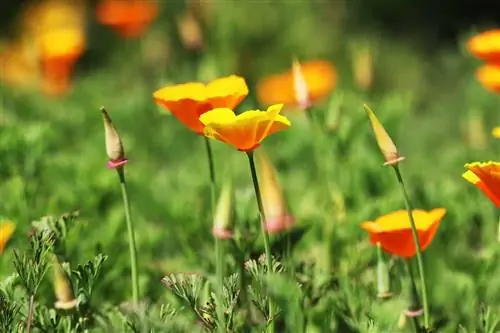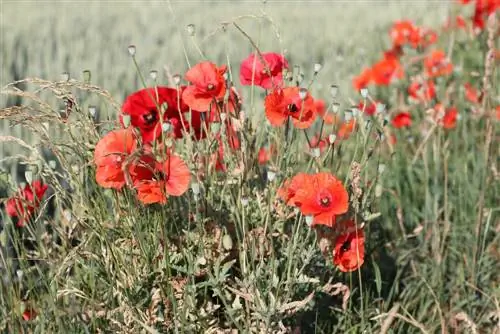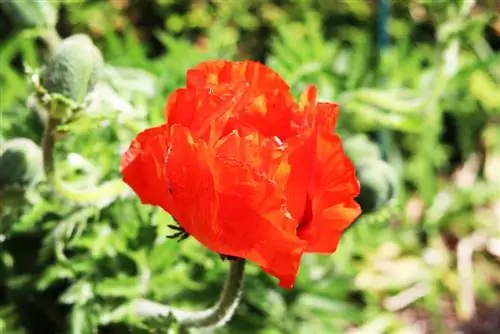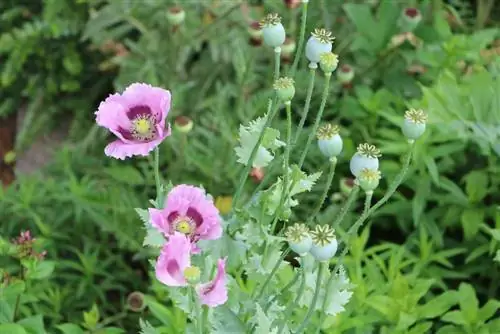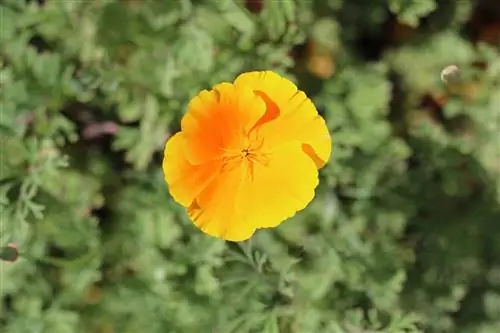- Author admin [email protected].
- Public 2023-12-17 03:39.
- Last modified 2025-06-01 06:48.
California poppy is particularly decorative thanks to its golden yellow flowers and is extremely frugal. Hobby gardeners do not need a green thumb to cultivate this pretty plant. Nevertheless, certain requirements regarding location and care should be met so that the sleepyhead
Location
California poppy is a sun lover and has a high light requirement, which is why it is preferably grown in a spot with full sun. In addition, it needs sun to open its flowers. If, on the other hand, it is cultivated in a semi-shady or shady location, not only does flower production suffer, because the existing flowers also remain closed.
- Full sunny
- Ideal in steppe or rock gardens
- Best cultivated over a large area
Note:
On cloudy days, the nightcap keeps its flowers closed, even in full sun.
Soil / Substrate
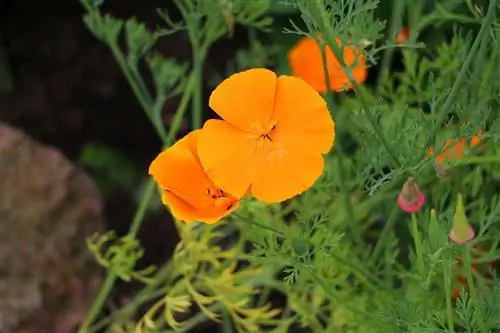
In the wild, California poppies prefer to grow in rough and rocky soils, sometimes even in inner-city areas. In the home garden, the lime-tolerant plant feels most comfortable in light clay or sandy soil. If you want to cultivate the plant in a flower box, it is best to use a commercially available potting soil and improve it with quartz sand, expanded clay or lava granules.
- Water permeable
- Nutritional Poor
- Dry
- pH value between 5.8 - 7.5
Pots / Buckets
Yellow poppies are not only a real feast for the eyes in the bed, because they also look particularly decorative on the balcony. Fortunately, it can be easily cultivated in containers - as long as they meet certain requirements. Pots with a diameter of around 12 centimeters are best suited for this. These should also be sufficiently deep so that drainage can easily fit in them.
Sowing
The best time to sow California poppies is between April and May. It would certainly be possible to sow it until June, but the flowering would then be postponed until the following year. Accordingly, it would also be necessary to get the Eschscholzia californica safely through the winter. For these reasons, sowing in spring is usually the better choice. Since yellow poppies are reluctant to be transplanted and pricked out, they should be sown directly where they will later bloom. The sowing itself is very simple and is as follows:
- Remove larger roots and stones from the soil
- Dig furrows about 1 cm deep
- Sow seeds about 10 cm apart
- Always keep it moist afterwards
- Optimal germination temperature: 15 to 18 degrees Celsius
- Germination time: about 10 to 14 days
Note:
A topsoil thickness of 25 centimeters is sufficient for the California poppy.
Fertilize
Fertilizing the golden poppy is generally not necessary because the nutrients contained in the soil are usually sufficient for the frugal plant. However, if the soil is particularly poor, fertilization can still make sense. In this case, fertilization with compost, horn shavings and some rock dust is recommended around six weeks after sowing. For golden poppies in flower boxes, however, fertilizing is generally recommended, although the following should be taken into account:
- Approximately every 30 days with liquid fertilizer
- Alternatively with slow-release fertilizer
- Sticks or cones
Note:
The peony poppy is a very lush growing variety that enjoys a small portion of liquid fertilizer every now and then.
Pouring
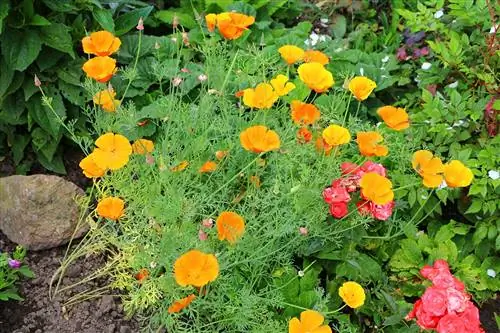
When it comes to water supply, it is better to be too dry than too wet. While the golden poppy can cope with dry periods quite well, it cannot tolerate waterlogging at all. As a rule, the natural rainfall is completely sufficient for the sleepyhead; watering in the early morning or late evening hours is only recommended in summer droughts. When watering, make sure that the water is distributed directly to the root area. Anyone who cultivates the California poppy in the flower box should also pay attention to the following when watering:
- More frequent watering necessary
- Check the earth's surface every few days
- Watering as soon as the soil layer has dried to about 2 - 3 cm
- Remove excess water after about 20 minutes
Repotting / Transplanting
The golden poppy doesn't like transplanting at all, which is why this measure is not recommended. It is best sown directly in the location where it will bloom in the future.
Cutting
Pruning is not necessary for the California poppy, as it is usually grown as an annual plant anyway. However, it is advisable to remove the wilted flowers regularly, as this promotes the formation of new flowers. However, if you live in a region with mild winters, you can cultivate the golden poppy as a perennial and leave the dead leaves directly in the bed so that natural winter protection is provided.
Wintering
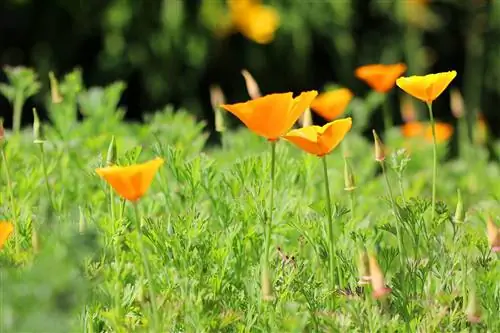
California poppy is hardy down to -10 degrees Celsius and can be cultivated and overwintered as a perennial in regions with mild winters. To do this, the withered flowers are removed in autumn and the fallen leaves are cut off close to the ground in late winter. If necessary, the leaves can be used as winter protection, although leaves, straw, brushwood or a reed mat are also very suitable. During the winter, watering is recommended when there is a clear frost on mild days. For gold poppies in pots, however, the following measures are recommended to get the gold poppy through the winter safely:
- Root ball can freeze outdoors
- Transfer potted plants to frost-free winter quarters
- Location can also be dark
- Cut off all parts of the plant
- Water every now and then
Propagation
If you want to propagate the golden poppy, you can do so very easily using seeds. There are several methods for this: On the one hand, the flowers can simply be left standing for self-sowing. On the other hand, the seeds can also be bought commercially or harvested yourself. The seeds themselves are found in cylinder-shaped pods that open on the long sides when ripe. As a rule, the small, dark seeds can be harvested in September and then dried and stored.
Diseases and pests
California poppy is relatively insensitive to diseases and pests. Fungal diseases such as mildew can only occur in damp or cold weather.

